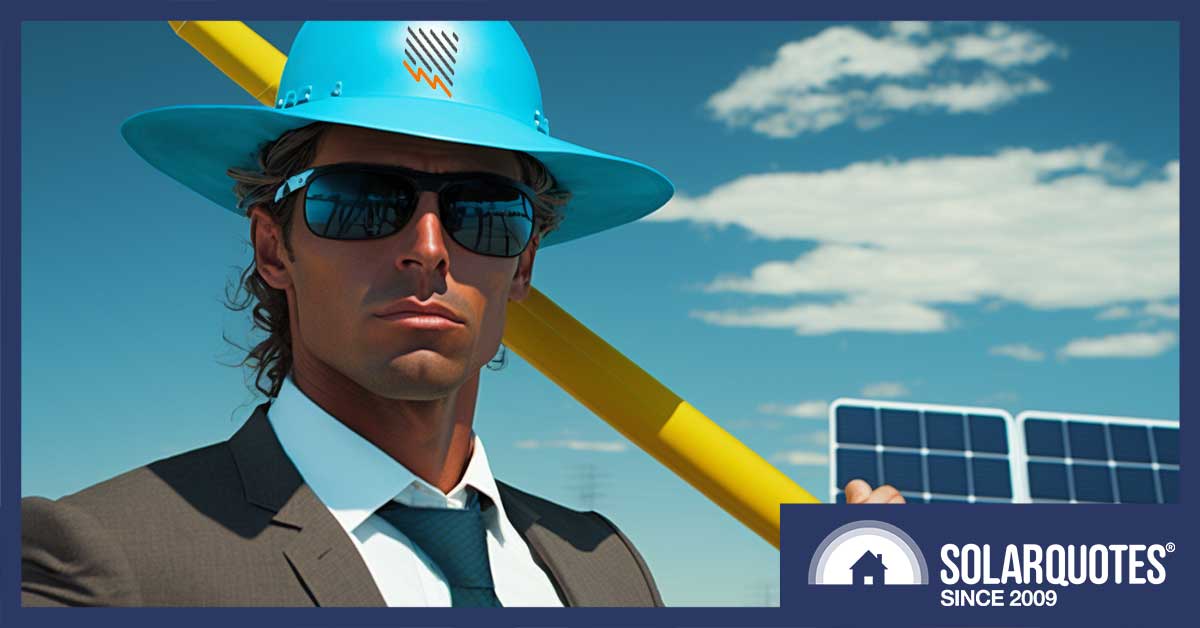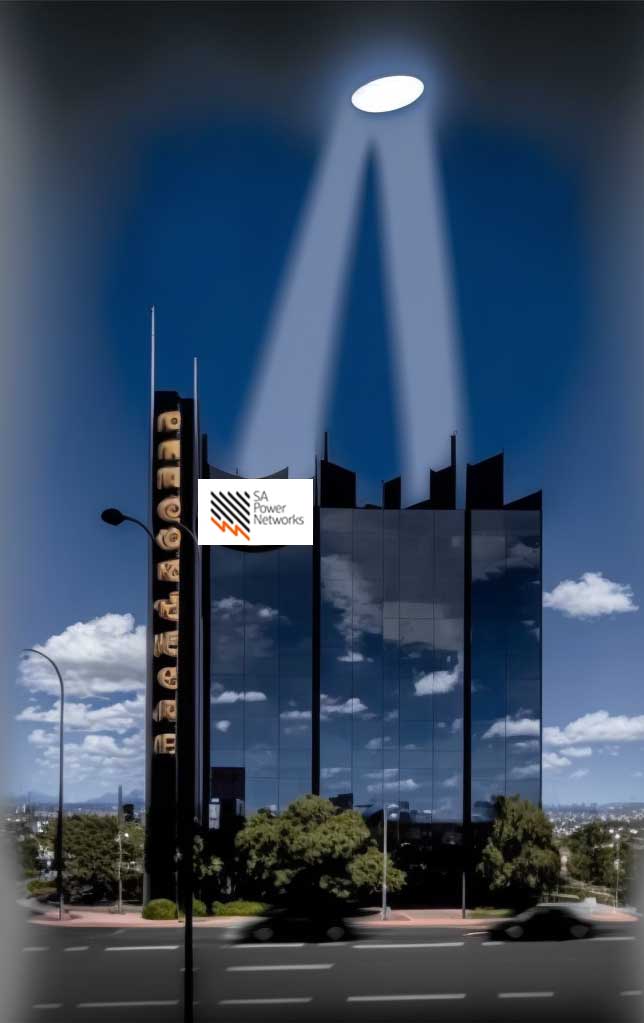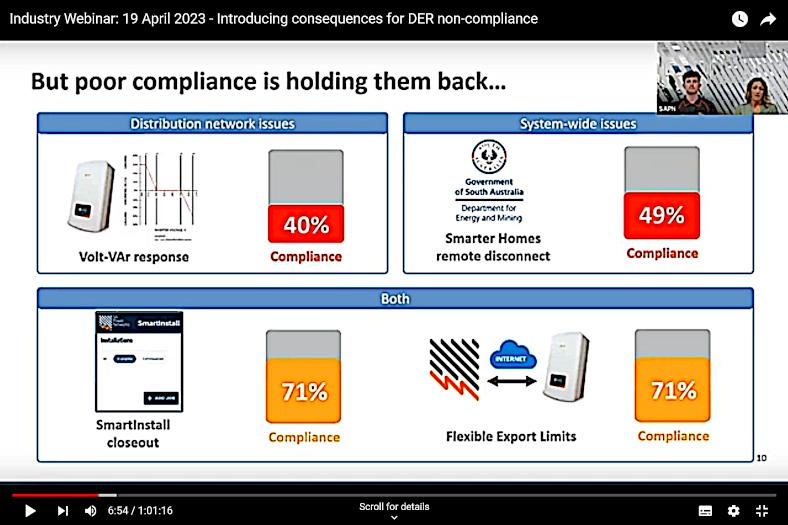
Are you *sure* you selected “Australia A” for Volt/Var response?
I recently received an invite from SA Power Networks to join them for a “free and informative webinar on the new automated feature for DER compliance management”.
You are probably thinking two things right now:
- “DER Compliance”? That sounds boring at batshit.
- Who cares about the inner workings of South Australia’s grid except for South Australian energy nerds?
But I recommend you read on wherever you’re from because this stuff is interesting, important, and coming to a renewables-heavy grid near you soon. And if we get it wrong, it will be a nightmare for the installers, the consumers and the electricity networks.
What The Hell Is ‘DER Compliance Management’?
Glad you asked. Here’s my Dummies’ Guide:
South Australia uses a lot of solar power and home batteries, known as distributed energy resources (DER). SA Power Networks (SAPN), the company responsible for distributing electricity in the region, wants to double the solar power capacity by 2025.
For this to happen, newly installed solar power systems need to be ‘smart’ and take directions from the electricity network operator: SAPN. Solar installers must ensure the systems they install follow SAPN’s DER compliance rules:
- Solar systems must be able to remotely turn on and off and adjust the power they export when SAPN send out the ‘Bat Signal’.
- If the home has opted into ‘Flexible Exports‘, the installer must register the equipment with SA Power Networks’ Flexible Exports program.
- Inverters must have the correct settings to maintain the quality of electricity. For example, they must adjust the power they generate in a specific way when the grid voltage gets too high – this is called ‘Volt/Var response’.

SAPN sending out the Bat Signal from 1 Anzac Hwy – asking South Australian solar inverters to stop exporting for a while.
SAPN is working with solar companies to ensure they follow these rules. They have a six-stage process to check compliance and use a traffic light system to show how well companies are doing. If a company doesn’t follow the rules, they could go into the sin bin.
SAPN’s Big Stick
SAPN told me that 90% of an installer’s work must be correctly connected and tested to prove DER compliance, otherwise they’ll be blocked from installing any more solar.
DER Compliance Management is a pain in the bum for installers. But it is about ensuring smart solar power systems communicate with the energy grid and follow the necessary standards to maintain a reliable and efficient electricity network. We need it in South Australia now. The rest of Australia will need it soon.
SA’s DER Compliance System Is Launching In May 2023
From May, SA Installers will have to use an online portal to both get permission to connect the solar system and check that it is DER compliant. The idea is that the compliance check is automated.
The process will mean that everyone has better visibility of what is connected and when it’s been finished. Reassuringly for me as an installer, there will be an ability to test the finished installation in real-time, to make sure that the inverter you’ve just commissioned will throttle off as required when the bat signal goes out.
And it seems we need a better compliance system because…
Current Compliance Is Not Great

Program the settings? For Volt/VAR compliance, the inverter menu might simply require the installer to select the setting: “Australia A”, but here in SA it seems 60% of installers reckon “This beer isn’t going to drink itself…we’re off to the pub”.
Compliance is awful at the moment. Inputting the correct Volt/Var settings should be a 2-minute job, but it has only 40% compliance. With mandatory remote disconnect, more systems are being installed without it than with it.
Most solar installers want to do the right thing, but they have a lot to think about on install day. Automated compliance management is long overdue, and will help solar retailers and installers in South Australia make sure they’re doing the right thing.
But DER Compliance Is Usually Dependent On A Fragile Wi-Fi Connection
Even if we get all new systems 100% DER compliant on the install day, there remains a very fragile link.
As an installer, WiFi is the bane of my existence. Making the physical connections with wires and conduits is easy enough; they’re tangible things. When the hardware won’t connect to the internet, the signal is weak, the server isn’t responding, the configuration doesn’t load, or the commissioning app is stuck in a boot loop… it’s enough to make you go postal.
The thing is that we are now relying on that customer’s WiFi connection, reliable or not, for energy system security. To my mind, it’s fraught with danger because once a resident moves house, the real estate agent is lucky to give you the right set of door keys, let alone the right security key for the internet router… which the old resident likely took with them anyway. And for the new people, once Netflix is connected, they will chill, blissfully unaware that the solar on the roof is crying out for a deep and meaningful connection too.
It strikes me as daft that we have internet-connected retail meters in every switchboard, and as solar installers, we can’t have access to that statutorily reliable 4G link to the outside world.
Sadly since the “power of choice” market reforms handed metering to the electricity retailers, nobody wants any responsibility for them.
For now, though, we can rest assured that as South Australia continues to pioneer new heights of renewable generation, SAPN will have better control to keep the lights on, the electric blankets warm, and the fridges cold. Flexible exports will be introduced in the new financial year, which means SAPN will be less likely to knock solar systems out by forcing high voltages onto the network if and when we have another round of spring storms.
There is a catch for the solar industry, though, and you might say it stems from the legacy of a public bureaucracy. We’ll call it a monopoly operator attitude. For years and years, ETSA, (who became SAPN) were forcing solar companies to update names, produce rates notices for addresses & otherwise do the basic admin work to get the network records in order. If we didn’t do as they wished, we didn’t get the grid-connect approval or the new retail meter installed.
Now we have a situation where a solar retailer can apply for a solar grid-connection agreement but if the installation isn’t closed out by the installing electrician, the solar retail company can’t move forward with more work. It makes some sense for small operators or those with staff entirely in-house. However, a subcontract installer may find they have an inordinate amount of power by withholding the compliance work.
It’s a legality for your electrician to fill out an eCOC (Certificate Of Compliance) to certify that electrical work has been performed to the appropriate standard, and that’s undoubtedly part of electrical contracting. SAPN now effectively demands an extra layer of compliance that no one is being paid for. The details already lodged in the eCOC must be entered again via the DER compliance procedure.
The Upside Of Stricter DER Compliance
It’s not all bad news for solar retailers. Dodgy sales companies and half-arsed installers are going to find it more difficult.
This could be a stroke of genius.
The whole regime of accreditation & CPD points hasn’t stopped poor installations. If, however, the actual installers are slack with compliance, they’ll soon find they don’t have any work because the companies creating the work won’t be able to make a sale.
Is It Time For Inspections By The Electricity Network?
DER compliance checks are another admin task the network should arguably be doing. If there were a network inspector who verified the installation before it was energised, then not just the compliance but the workmanship would have to improve across the state.
I would support random audits, but a compulsory inspection would be another round of appointments and site visits, which will be paid for by the electricity user eventually. Does anyone have time for that when we should all just be installing more solar?

 RSS - Posts
RSS - Posts



Screw that, I don’t want anyone mucking with my Battery output but me, how am I supposed to stay ahead of the shifting energy plan goal posts, it’s bad enough I’m limit to 5kW. Just upped my system from 9.6kW of panesl to 13.3, and a 16kwh battery, right before AGL are mandatorily changing my plan for the worse, good timing as I am now essentially off grid, except for those cloudy days.
Connections with 802.11 WiFi is problematic. because it is a shared wireless space. There is no control over who uses which channel and many devices default to US channel plan in the 802.11b 2.4 GHz. In the 802.11 a %GHz space channels in some area are limited by Radar transmission,
We should be recommending all fixed devices should connected to the local router via ethernet wired connections.
Malcolm, you’re assuming the house design facilitates that sort of routing.
My place was built with hardwired connections except the builders put FTTP connection ports in the garage. The thing is I live in a barely FTTN area and the hub for all the hardwired house connections is on the opposite side to the garage. I can bridge the FTTP ports with a simple network cable, but the inverter, also in the garage, struggles to maintain a wifi signal. Could I shift a router out to the garage? Sure, in theory. But there’s nowhere to place it and I’d need a 2nd router in some sort of master-slave relationship. I’m not an IT expert, don’t want to mess up my phone and internet, so it’s simplest to ignore the garage’s network issues.
How many others would be similarly disinclined to mess with technical stuff, especially knowing doing the wrong thing could leave them disconnected from the world?
Warren,
The problem with WiFi is the main point.
There should be an ethernet cable from your FTTP point to your Router.
You should also have an ethernet cable run from the solar inverter to your router and plug into a port on your router.
Running WiFi on your solar inverter is problematic as any changes to the security of you house WiFi will also mean your solar installer will have to change their settings.
If the solar inverter is directly connected via cable to your router and also ensuring that the inverter has DHCP enabled then there will be no problems with connectivity. The standards for communications cabling should be followed. The length of the cable can be over 80m.
When I had my solar installed I insisted the the installer run the ethernet cable from the inverter to my local network hub.
This is another example of regulations being way way behind the technology. What about existing long installed systems ? I would rather NOT export anything then mess with DER or export licensing etc.
Are SAPN going to pass on all that data to the AEMO’s DER Register so installers don’t have to key in all those serial numbers a 42nd time to yet another database?
Death by 1000 bureau cuts.
I do think DER compliance is necessary, but am shocked that the utility was sleeping and ignoring this for so long. I am looking forward to the day when I can be paid to supply energy to the grid in times of need. That can be more profitable than all of the export credit I now get for producing power I don’t use.
Home solar is finally taking off, but the number of competent installers is sadly in short supply. Lots of growing pains in many areas.
How will this integrate with battery systems? The last thing I want is my inverter being throttled at 10am when my battery is still low from the night before. When the whole system is AC coupled there’s no easy way for the battery system to throttle the inverter, Tesla powerwalls can only control inverters when they are in off grid mode.
A well-designed system will simply go into zero-export when the bat signal goes out. A poorly designed system will cut the power to the inverter and stop all solar generation.
I have 2 systems, grid for welding etc and more than 3 days of rain and off grid. Separate systems, no hassle.
Hi Richard this is exactlly what I have done . Screw the grid,microgrids are the future. The trouble is our economic systems will not consider independent user systems which technically can be done.
I don’t think regulators realise just how soon off-grid is going to make economic sense. And all those nice fat connection fees and free energy we feed the grid with the profit going anywhere but to us, is just going to evaporate.
Strong disagree. A little curtailment makes almost no difference to the economics, and certainly does not get close to making up for the extra costs of going 100% off grid. The network (the grid) adds immense value – especially if you have batteries which can arbitrage fluctuating grid prices.
Curtailment makes a difference when I an trying to charge my car at home so if i am charging with 10KW and SAPN curtail me down to 5kw, Do i lose out on the 5KW I could of sent to my car?
So SAPN zap me of my investment in solar when I use charge HQ to balance my grid / solar to my car.
It depends on how the curtailment is done.
South Australia’s ‘Dynamic Export Limiting’ or ‘Flexible Exports’ only curtails exports. So if you are generating 10 kW and charging your car with 10 kW and the Bat Signal tells your inverter to curtail exports to 5 kW, you can continue to charge at 10 kW from the solar. Your solar will only curtail if it starts to export – and only by enough to get the export down to zero.
With the ‘Remote Shutdown’ system in SA (only used during extreme grid stress), if your system has been well designed, it will move to an export limit of zero – you’ll still be able to charge your car with 10 kW of solar if there’s enough sun. If your system simply uses a smart meter contact to kill the inverter – you’ll lose all solar.
One thing that zero export limits can mess with is smart solar charging – but that’s a whole other blog post.
Hi Finn, Many thanks for your solar insights.
I designed my off grid system before the government began paying people 60cents per kWh because we get plenty of storms and consequently blackouts plus I’m an independent old bugger. Cost was not the reason. I like the fact that I always have power at a specific voltage that suits my needs. Could you please explain to us the reasons the grid can go over voltage
Hi Richard,
Grid voltage to your house is regulated under the national electricity rules to be a nominal 230v with a tolerance of -6 to +10% ie 216 to 253v. In a practical sense it’s a push/pull between the supply authority (DNSP) versus number of customers, the amount of energy they’re using and increasingly the amount of energy they’re generating.
The DNSP has always had to regulate voltage by doing what they call tap changes, switching transformer windings manually at nearby transformers, or automatically for network scale at your local sub station. Usually that meant turning voltage up in the morning, to meet load when all the kettle & toasters come on, then tuning it back down at bedtime.
Now DNSPs have to be very proactive. Transformers are tapped up when more customers are added to a street, (such as when a big block is subdivided for 6 townhouses) but when all the customers on the street install solar, they may have to tap the transformer down again, sometimes running out of adjustments because the transformers were never designed for a system that runs in both directions.
Now because the energy system is being driven from the bottom up, with rooftop solar which waxes and wanes with the cloud cover, voltages are more volatile. The upshot is that we will need much smarter control of loads going forward. DNSPs are in some cases crying out for more load during the day, which can be in the form of car charging and hot water, while at other times they are looking to moderate load such as cold windless nights when everyone comes home to cook tea.
I hope that helps explain but have a look at the blogs and search the FAQs for more.
https://www.solarquotes.com.au/blog/sa-off-grid-renewables/
https://www.solarquotes.com.au/blog/solar-voltage-rise-drop/
Cheers
Some modems / routers allow you to have multiple SSID (internet access names)
I have setup a separate SSID called “Solar_Telemetry” and it has a separate unique password. The rest of our family use friendly SSIS name I called “Lemon Zest” and that uses a family password. Overall easy to do “ if you are reasonably comfortable with IT stuff “. ?